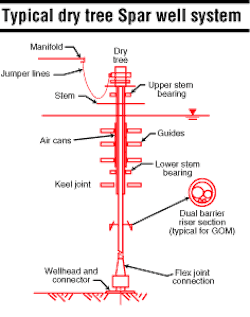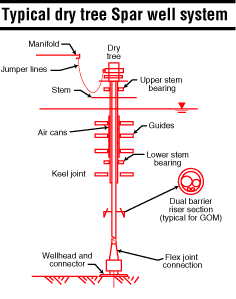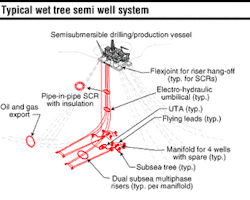Dry vs. wet trees on production platforms with direct access wells in ultra-deepwater
By Richard D'Souza, David Anderson, Dave Barton
Kellogg Brown & Root, Offshore Technology Group
Assessing the technical and execution risks
In the deepwater Gulf of Mexico, operators most often select dry-tree production and drilling (PD) platforms - Spars and tension leg platforms (TLPs) - to develop reservoirs with sufficient reserves to justify a production hub and with direct access to the development wells. The preference for dry tree solutions is attributable to the fact that drilling and access for well interventions represent extensions of familiar, shallow-water platform practice. Until now, PD semisubmersibles (PD semis) that offer the same functions but with trees at the seabed (wet trees) have been largely overlooked.
However, operators are being compelled to reappraise this strategy as the rapid progression of developments into ultra-deepwater, 1,500 meters and beyond, raises concerns about the commercial competitiveness and technical issues related to dry tree platform well systems. There is also a worldwide trend toward greater use of subsea developments. The result is continuous improvement in well system reliability and availability with accompanying reduction in component and well intervention costs. Globally, over 70% of the wells in deepwater developments that are either in service or committed are subsea. This statistic demonstrates the industry's confidence in these systems.
Topsides
Topsides real estate is at a premium on a floating platform. The challenge is to provide efficient deck layouts for topside equipment required for drilling and produc-tion functions that are consistent with safety and operability.
Dry tree platforms have a large central well bay for the surface trees. The size is dictated by well count and spacing. Topsides equipment has to be arranged around the well bay. The surface trees are designed for full reservoir shut-in pressures. A large production manifold is required on deck, and a skiddable rig is required for individual well intervention.
Wet tree platforms have a central moonpool for running marine risers, subsea blowout preventers (BOPs) and trees. The marine risers and BOP are heavy and require large deck areas for storage and handling. However, trees are manifolded and shut in at the seabed while the drilling rig is fixed.
Dry tree platforms require larger deck areas and pose greater challenges for arranging topside equipment than wet tree platforms with comparable functionality and safety. These drawbacks are partially neutralized by the heavier marine risers and BOPs required for subsea wells. The gap narrows or expands with well count.
Hull and mooring system
The PD Spar hull weight is relatively insensitive to water depth since the production risers are free-standing in the center-well and tensioned by air-can systems. Alter- native top-tensioned riser systems are being considered, but their impact is not addressed. The center-well size, and hence hull diameter, will increase with well count, but the hull buoyancy requirement is not affected, and the impact on hull cost is modest.
The PD semi hull weight is similarly insensitive to water depth and well count. Nominal added hull buoyancy is required to support incremental tension loads from production/export risers. These could either be steel catenary risers (SCRs) or tower risers. Hull motion, offsets, and SCR response are dyna-mically coupled. Global response of the semi is stable and predictable in all environmental conditions.
Both semi and Spar hulls can be moored in up to 3,000 m water depth with conventional wire-chain spread mooring systems to maintain offsets required by production risers and for drilling. Maintaining reasonable total vertical "stroke" of Spar production risers requires a tighter watch circle with increasing water depths. There are no such constraints for the semi. The result is that mooring system costs will increase at a greater rate for a Spar with water depth. Extreme loop currents could control mooring system design for a classic Spar, exacerbating the cost spread between mooring systems. Unbalanced horizontal SCR loads could increase demand for a semi mooring system.
Well systems
A typical dry tree well system for a PD Spar requires that each production riser be individually tensioned by an air-can system in the center well. Horizontal guides within the center well permit relative vertical movement between the hull and riser. The air-cans provide sufficient tension to support the wet weight of the dual-barrier, insulated riser system while preventing clashing with other risers in the array. The buoyancy requirements, and hence the size and weight of air-cans, increase significantly with water depth and reservoir pressure.
A typical wet tree well system for a PD semi includes several trees that are manifolded at the seabed. Co-mingled flow is carried by dual-insulated flowlines and SCRs suspended in porches on the pontoon of the semi hull via flexible joints. An umbilical riser provides control functions to the subsea trees. Riser tension-loads supported by the semi hull increase with water depth in proportion to the suspended weight of SCRs. An alternative riser system is the submerged, freestanding tower riser tensioned by a combination of syntactic foam and air cans, with flexible riser connections to the semi.
Differential capital cost between the wet and dry well systems is a function of water depth and well count and varies for normally pressured wells. The cost differential is generally small in the 1,200 m to 1,800 m water depth range, but strongly favors wet tree well systems beyond 1,800 m. The differential cost between the systems is greatly magnified for high-pressure wells. The main reason for this difference is that there is one production riser per each dry tree well vs. two production risers for four (or more) wet tree wells. The wet weight of the dual barrier dry tree and size of air cans increases significantly with water depth and internal design pressure.
Topsides integration, hook-up, and commissioning installation are a major cost and schedule differentiator between the PD Spar and PD semi. Typical scenarios for base-case platforms are described to facilitate cost and schedule comparisons.
The base case PD Spar hull will likely be built in a Far East or European shipyard, dry towed to the GoM, commissioned quayside and then wet towed to site and upended. It will then be hooked up to preset moorings and several thousand tons of fixed ballast added to tanks at the base of the hull for stability, in a lengthy offshore operation. Topsides modules will then be lifted on by a heavy lift crane vessel, followed by an extensive offshore hook-up and commissioning period, while production and export risers are installed. The first predrilled well can then be completed and first oil achieved. A typical GoM deepwater well completion is estimated at 30-35 days. Other predrilled wells are completed and brought on stream sequentially. Depending on the number of wells required to fill the production facility, it will take several months for a PD Spar to reach peak production following first oil. Elapsed time from first oil to peak oil for the base case PD Spar will be about six months.
The base case PD semi hull will likely be built in a Far East shipyard along with a significant part of the deck and drilling topsides. The hull will be dry towed to the GoM, where the remaining topside modules will be lifted either quayside or nearshore, followed by quayside hook-up and commissioning. The platform is towed to site and hooked up to preset moorings, followed by hook-up and commissioning of production and export risers. Peak oil from all predrilled and precompleted subsea wells follows within weeks.
Estimated total cost for all tow and installation activities is similar for the base case platforms. The cost of topside hook-up and commissioning activities is 25% greater for the PD Spar because a large percentage of hook-up and commissioning man-hours is offshore.
Economic impact
Differences in actual volume and timing of produced hydrocarbons over the life cycle from first oil provide a measure of the relative economic impact for the wet and dry tree systems. The ability and ease of well intervention to conduct a variety of downhole operations has a direct influence in reservoir management (total recovery) and production efficiency (ratio of achieved vs. required production). Dry tree platforms provide easy access to the well bore for intervention. However, the PD semi provides direct access capability to local wells for intervention operations resulting in comparable per well and total recovery. The major difference is the additional intervention duration (running marine risers and BOPs) and associated lost or deferred production.
Well intervention
All wells require routine or unplanned interventions for maintenance, data gathering, or reservoir management. These interventions can be categorized by frequency and duration. Frequency is a function of many variables including specific reservoir characteristics, well construction, completion type, and reliability of subsea and subsurface equipment.
Heavy intervention operations require produc-tion tubing removal and a drilling rig, marine riser, and BOP to perform safe operations. Causes include tubing failure, casing failures, gravel pack or sand screen failure, production isolation, and replacing wellhead connectors.
Light intervention operations are those where downhole service is performed through the wellbore. This includes all slick line, wireline, and coiled tubing work that can be performed without pulling production tubing. Operations include routine production logging, well stimulation, paraffin/asphaltene/hydrate remediation, changeout of downhole values, and reperforations.
Minor workovers are intervention services performed through flowlines or umbilicals, such as pigging, bullheading scale, or hydrate inhibitors, into a wellbore. Also, there are services performed external to the wellbore such as remotely operated vehicle services, control-pod and choke-module changeout on subsea trees, manifold and jumper inspections, etc.
Drilling, operation costs
An assessment of costs associated with drilling and completing local wells from the PD Spar and PD semi platform rigs indicate that there is no measurable difference in cost or duration for similar well construction for surface or subsea well systems.
There is similarly little measurable difference in annual operation costs between the two systems. Topsides fixed costs for personnel, transport, support equipment, and rig maintenance are the same.
Ultra-deepwater presents flow assurance challenges to both wet and dry tree platform well systems. Production risers in the water column dominate overall hydraulic and thermodynamic system performance.
Well system architecture for both wet and dry platforms incorporate design features to mitigate and remediate blockage due to formation of wax and hydrates. Features include insulation, dual flow paths, supplemental dead oil circulation, chemical injection, and blockage remediation via coiled tubing.
Early first oil and peak oil strongly favor the PD semi. Early peak oil benefit is achieved because all the predrilled subsea wells required for peak production can be precompleted. Some of the benefit is lost because of the added cost of the leased rig that precompletes these subsea wells.
System flexibility and risks
In ultra-deepwater field development concept selection, operators are often faced with the problem that commercial metrics, such as capital cost or net present value (NPV), are often inconclusive. In the base case developments examined, the commercial metrics favor the wet tree concept over the life cycle, but the benefit is not overwhelming. When this is the case, the operator must thoroughly assess other important differentiators before making the final selection, which are:
- Flexibility to accommodate uncertainty (reservoir, production capacity, execution)
- Technical and execution risks.
Conclusion
Selecting a development concept for an ultra- deepwater field is a challenging undertaking. For GoM fields that can be developed from a single drill center, the choice of hub concept narrows to a PD Spar with dry trees and a PD semisubmersible with wet trees.
It is concluded from comparative assessment of a large PD Spar and PD semi in 6,000 ft water depth that a PD semi is a commercially competitive option principally because of the lower well system and topsides hook-up and commissioning costs and the shorter cycle time to first oil and peak oil. The PD Spar has better production efficiency over the life cycle because of the relative ease of well access for downhole interventions, but the difference is not decisive.
The assessment concludes that the PD semi will provide better NPV than a PD Spar. A qualitative assessment of relative risks and flexibility to accommodate reservoir uncertainty tends to favor a PD semi. Extensive offshore installation and hook-up and commissioning activities increase the schedule risk of the PD Spar.
The more fundamental message is that the concept selection process for ultra-deepwater developments is an important step in ensuring eventual project success. As each reservoir presents unique challenges, so will various field development options. It is strongly recommended that a thorough and objective assessment of wet and dry tree options be conducted during the selection process that includes costs, risks, and flexibility considerations to ensure that the development concept that best matches the reservoir characteristics is selected.
Acknowledgements
The authors would like to thank Catherine Marrs, Chuck Kerr, Myles Butler, Jay Weidler and Tom Bauer of KBR Offshore for their support and the KBR management team for their sponsorship.
References
Chitwood J.E.; "Subsea Intervention Requirements," 2nd Intl. Deepwater Technology Conference (World Oil); 1998.
Golczynski and Niesen, "A Tale of Two Trees: Flow Assurance Challenges for Wet Tree and Dry Tree Systems in Ultra deepwater," SPE 71545 2001.



